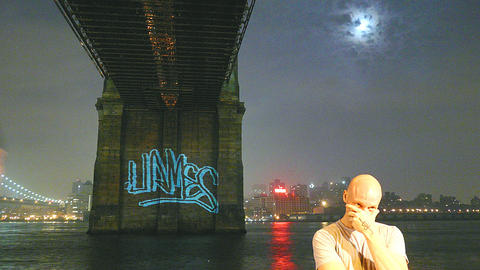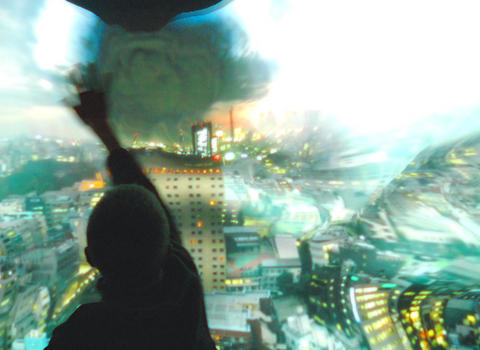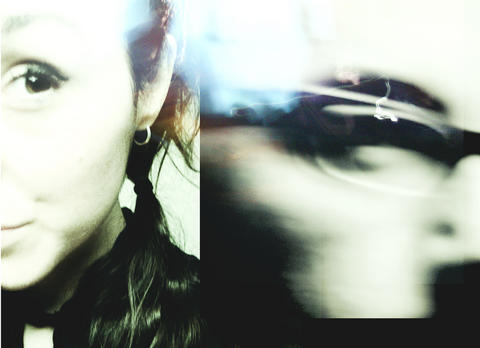G raffiti artists need fear the law no longer - at least that's the word on the street in New York. Two artists versed in "tagging" have come up with a state-of-the-art computer program that enables graffiti writers to replace spray paint with light using a camera, laptop and projector. Combined, artists can project graffiti onto the side of a building. And in the spirit of the creator's open-source ethos, the code for the program, L.A.S.E.R. Tag, is posted online for enthusiasts and artists to "download, dissect, reuse and hopefully improve," according to Graffiti Research Lab's (GRL) Web site (www.graffitiresearchlab.com).
GRL's program is one of the many creations going on display tomorrow as part of Openplay Digital Art Festival in Taipei that runs until Dec. 2 at the Red House Theater (紅樓劇場) in Ximending (西門町).
The participating artists are known as much for their technological prowess as they are for their art. Many of the projects began as research and were then developed into art or, in some cases, for commercial use. And although it required considerable technical skill to create the works - some of the artists have PhDs in computer science or engineering - the creations are relatively simple to understand and manipulate.

PHOTO: COURTESY OF THE DIGITAL ART FESTIVAL
For Valentina Vuksic's installation, Harddisko, the artist gathered 16 defective PC hard disks, removed the casings and connected them to a sound mixer using simple electric circuits. As soon as the power is turned on, the disks move in specific patterns and generate sound. The result can be compared to an orchestra of various instruments.
Like Harddisko, Interactive Sonic Systems' ReacTable is a digital musical instrument. It consists of a round table set with illuminated plastic picture tiles. Each one generates a specific sound or modifies sound in some way. Visitors play it by arranging and rearranging the tiles, producing a variety of sounds. The ReacTable also provides visual feedback on the table.
Instead of playing with sound, Alvaro Cassinelli's The Khronos Projector allows viewers to explore prerecorded movie content in new ways. Rather than viewing a movie chronologically, the user is able to send parts of the image forward or backward in time by touching the projection screen. For example, the image of a daytime cityscape becomes, at the point where the hand or finger moves along the surface of the screen, dusk and eventually evening. As soon as the viewer's hand is lifted, the screen returns to the daytime scene.

PHOTO: COURTESY OF THE DIGITAL ART FESTIVAL
The Robotic Chair by Canadian artists Raffaello d'Andrea, Max Dean and Matt Donovan, falls apart and puts itself back together. Watching the wooden, classroom chair spontaneously fall apart and gradually reassemble itself is a surreal experience, and seems to be a statement about the ability of humans to do the same.
Contemporary art, it would seem, has split into two parts: that which is looked at and contemplated and that which is played with and manipulated. The works at the second Digital Art Festival fall into the latter category and visitors should be fascinated, regardless of what their definition of art is.

PHOTO: COURTESY OF THE DIGITAL ART FESTIVAL

Nov. 11 to Nov. 17 People may call Taipei a “living hell for pedestrians,” but back in the 1960s and 1970s, citizens were even discouraged from crossing major roads on foot. And there weren’t crosswalks or pedestrian signals at busy intersections. A 1978 editorial in the China Times (中國時報) reflected the government’s car-centric attitude: “Pedestrians too often risk their lives to compete with vehicles over road use instead of using an overpass. If they get hit by a car, who can they blame?” Taipei’s car traffic was growing exponentially during the 1960s, and along with it the frequency of accidents. The policy

Hourglass-shaped sex toys casually glide along a conveyor belt through an airy new store in Tokyo, the latest attempt by Japanese manufacturer Tenga to sell adult products without the shame that is often attached. At first glance it’s not even obvious that the sleek, colorful products on display are Japan’s favorite sex toys for men, but the store has drawn a stream of couples and tourists since opening this year. “Its openness surprised me,” said customer Masafumi Kawasaki, 45, “and made me a bit embarrassed that I’d had a ‘naughty’ image” of the company. I might have thought this was some kind

What first caught my eye when I entered the 921 Earthquake Museum was a yellow band running at an angle across the floor toward a pile of exposed soil. This marks the line where, in the early morning hours of Sept. 21, 1999, a massive magnitude 7.3 earthquake raised the earth over two meters along one side of the Chelungpu Fault (車籠埔斷層). The museum’s first gallery, named after this fault, takes visitors on a journey along its length, from the spot right in front of them, where the uplift is visible in the exposed soil, all the way to the farthest

The room glows vibrant pink, the floor flooded with hundreds of tiny pink marbles. As I approach the two chairs and a plush baroque sofa of matching fuchsia, what at first appears to be a scene of domestic bliss reveals itself to be anything but as gnarled metal nails and sharp spikes protrude from the cushions. An eerie cutout of a woman recoils into the armrest. This mixed-media installation captures generations of female anguish in Yun Suknam’s native South Korea, reflecting her observations and lived experience of the subjugated and serviceable housewife. The marbles are the mother’s sweat and tears,